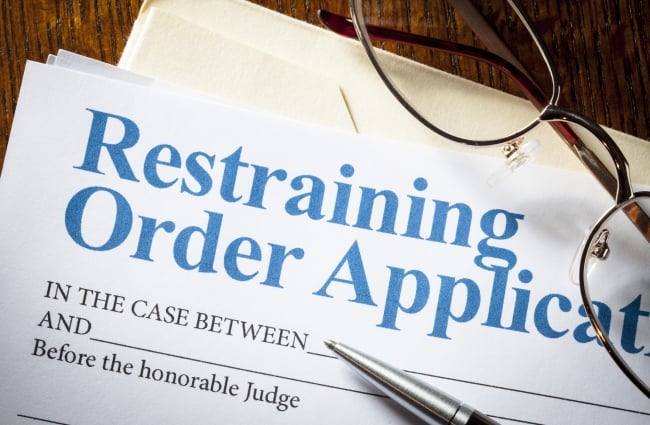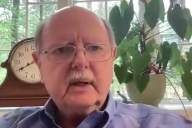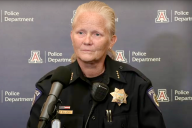You have /5 articles left.
Sign up for a free account or log in.

Bill Oxford/iStock/Getty Images Plus
Academics and researchers are regularly facing threats of violence. These take an emotional toll and can have deadly consequences, as we saw with the 2022 murder of Tom Meixner at the University of Arizona, allegedly by a former student.
I, too, have faced threats of violence related to my work as a faculty member. As I reflect on the fact that neither my past nor present institution had a clear response plan in place a priori, I felt it time to begin the dialogue. I do so by sharing my own experiences, how my institutions have responded to support me and reflecting on how institutions could improve their support for researchers facing threats of violence. I have now experienced threats on two different campuses and worked with two sets of campus police, local police, public safety teams, deans, colleagues, local justice systems and students to respond.
Few who know me will have heard me share this story before, for a few reasons. First, I convinced myself it was a unique experience in my past and wasn’t something others would go through—why broadcast a deeply personal, traumatic and unique situation? Moreover, I did worry that by sharing my own story I could put my family at risk. I must also acknowledge that as a middle-class, cisgender, heterosexual, able-bodied, native-English-speaking, white male born in the U.S., I experience a minor fraction of the harassment or threats some of my colleagues and friends live through based on who they are—should I share my own experience when I know for a fact others face harassment more frequently than I do? Maybe I’m just coming to terms with experiencing harassment for the first time.
With these fears and hesitations, without knowing who else I could talk to and frankly because it was traumatic in the moment, I kept quiet. So why share now? If no one shares, it is easy to assume threats against faculty don’t happen and for our institutions to ignore the problem. But threats, harassment and violence on campus are more common than you would think and stem from all sorts of reasons (race, religion, gender, culture, area of scientific research and more). While our campuses are rightfully working hard on student safety, we have much progress to be made.
The events surrounding the murder of Tom Meixner—who, like me, was a hydrologist and department chair facing threats from a former student—were triggering and brought back a lot of stresses that I thought were in my past. I realize that I am still coping with this every day and the stresses are right back at the surface sometimes with little notice.
I recently moved institutions and am re-learning how to find, navigate and marshal resources on campus. I suspect many of my colleagues haven’t thought much about how they would respond to campus violence, and I hope they will use my story as a catalyst to begin a conversation at their own institutions.
With that—here we go. What follows is my own experience. To my colleagues, I want you to know you are not alone when you face threats and there are varied degrees of resources from your employer and local law enforcement that may exist to help you.
A Shocking Threat
It is a Tuesday evening in 2019. The kids are in in bed, and I’m packing to travel for work the next morning. The doorbell rings. Two campus police officers are at my door. We invite them in, with quiet voices to not wake the kids.
Police: “Do you know X?”
Me: “I don’t think so.”
Partner: “I don’t.”
Police: “X seems to know you. Possibly a former student?”
I look back at class lists. Turns out I do know X. They took one class with me several years ago in which they earned a good grade. I recall one visit to office hours to discuss careers, and I haven’t heard from them since. I was not their adviser, primary mentor, nor otherwise engaged in their life. I had nothing but a normal if unremarkable relationship with X, like I’ve had with hundreds of students over the years. I tell the police as much.
“So … why are you at my door? Is X OK? Do they need help?” My brain is spinning in all sorts of directions. They show me a photo of the person, who does ultimately look familiar.
Police: “X has been fantasizing about killing you and your family for several years …”
WTF is happening? I’m not hearing this correctly. Did the police just say someone is trying to kill me and my family? Are the kids OK right now? What do we do with this knowledge?
Police: “… so they have been discussing this with their mental health provider for years …”
Wait, what? A person has been plotting to kill me, my partner and my kids for years? Why am I just learning about this? What did we do? Why are we unsafe? What has triggered this?
Police: “… when they began to act on these fantasies, their mental health provider reported it to the police and it came to us to notify you …”
(I eventually came to understand that mental health providers can break confidentiality when patients transition from thought to action, meaning a credible threat to others is present. Apparently, we met that bar).
What do we do now? The police have no reason to believe we are in immediate danger. They will make contact with us tomorrow midmorning. They leave with advice to lock the doors and be aware. The kids are sleeping and we don’t want to scare them, so we lock up for a sleepless night. I cancel the travel I had planned for the next day. Is it safe to stay here? Do we wake the kids and move them to a hotel right now? Is that too traumatic for them?
I call my dean, because … well … who does one call? How do we respond? I need security at my home, my office, the office of my partner (also a university employee). I call our staff who are at the front lines when people come to our buildings. I call my students. I cancel meetings this week. I cancel class.
My partner and I triple-check the house is locked, turn on all lights outside and downstairs and confirm a can of back-country bear spray and flashlight are within reach. We settle in for not a wink of sleep during what is perhaps the longest night of my life.
It’s morning and the kids are stirring. We get them dressed, fed and out the door to school. We’re trying not to worry them so their day can begin normally. As soon as they’re on the bus, we immediately arrange to move to a hotel for the foreseeable future.
Next, we go to the police station on campus. We learn more about why they came to our home last night. X has reported to their mental health provider that they have visited our home and our offices.
What? Were we told this last night? Did we miss it? We feel massive confusion as we try to respond, feeling our home and work have been violated. Did we have evidence of this? Had we noticed anything?
Yes. Turns out we did. Objects left outside our home (near the windows, where you’d be standing looking in), at our offices. Lots of people ask what was left, expecting an answer from a horror movie. Nope. Just day-to-day sort of objects, like someone would have dropped from their backpack or a neighborhood kid would have left accidentally. Not something notable nor out of place, so not remarkable. But taken together this adds up to a pattern—hindsight.
The police add our home, campus buildings and kids’ schools to their “drive-by” list. They are watching for X and their vehicle.
Now we are back home to pack for the hotel. Our neighbors saw the police and are asking for details and how to help. Neighbors saw a car parked that was unfamiliar and a person strolling back and forth on the sidewalk in front of our home. The police recover a pair of muddy boots from where the car was parked.
Muddy boots in the middle of a suburb? Another neighbor saw a person in the field behind our house a few days ago. The description fits X, and the reported clothing will later match images we find on security cameras at our offices. We pass all information on to police.
We check in at the hotel. I try to explain to the front desk staff why we need a different name on our hotel room. They’re stunned, but quite helpful. We’ve got a few hours before we pick up the kids from school. Next stop is the county courthouse.
We have no idea what we’re doing, but inquire about a restraining order. Will a sheet of paper protect us? Not really, but it is all we can think of. What else does one do? Now we’re meeting with a case worker. We need to establish a pattern of threatening behavior and provide evidence. The police telling us about the threat isn’t sufficient. The case worker wants to help but cannot until she has evidence in hand.
Somewhere along the way, we are letting our close colleagues, friends and family know what is happening. Multiple people offer to teach me how to shoot a gun or to come armed to our home if that will make us feel safe. Guns aren’t our thing. But we consider this—I will lie awake in bed that night looking at fingerprint-secured lockboxes. Stress responses make you do weird things. I’ve never owned nor shot a gun.
It is time to pick up the kids from school. We surprise them: a weeknight stay at a local hotel! We can swim in the pool and order pizza. They don’t know what is happening; they are having an adventure. We’re exhausted but putting on a happy face.
(I should say we try to be very honest with our kids and teach them about the world. We don’t shy away from complex issues. But we don’t understand this situation, so we’re hiding it for the time being. Parenting is hard. The kids don’t know about this specific threat, though we do talk regularly about “stranger danger.” They will have tools to respond, if they need to.)
We wake now 36 hours after police notified us and get the kids to school again. We get a local provider booked to rush an installation of a home security system tomorrow. Sensors, cameras, the works. We want to sleep in our home again and feel safe—we hope this will help.
A pattern is emerging in my experience. I’m lucky to have ample resources to fund our responses. Hotels, alarm systems, flexible work schedules, a support network of neighbors and friends. I don’t know how we would manage without any one of those advantages.
Back to the task at hand—gathering evidence for the restraining order. We work with our building managers to access security footage. We document X visiting both of our buildings, lingering outside of our offices, leaving objects from their backpack. We later learned campus police already had this footage but didn’t share it with us. Thus, it was on us to obtain the evidence.
Meanwhile, university police has served X a trespass order, barring the person from all university properties. The university did this without our having to ask for it. This is a proactive response; it makes us feel police are supporting and helping. We later find out the police also looped back to the mental health provider, asking if X met the criteria to be immediately detained. X did not.
Back to the courthouse. We now have enough evidence for a temporary protective order. We file, seeking a restriction on the person owning or possessing weapons including firearms, knives and more. Somewhere along the way we have picked up some photos, details about X’s vehicle and license plate. We produce a flier and distribute it in our neighborhood and work buildings to raise awareness and protect ourselves.
The university’s general counsel updates us on the trespass order. We ask if they will be supporting our efforts for a protective order, acting as our legal representatives or paying for our legal expenses since this is occurring at and attributable to my job. They aren’t sure—after all, the university counsel represents the university, not individuals. They direct us to a law clinic on campus.
The faculty lead for the law clinic drops everything to help me understand what is coming next with our protective order. While their clinic sees lots of cases each year, this one hit home for the faculty lead. They seem jarred by a fellow faculty member experiencing threats and stalking.
My key takeaway is we need a lawyer, and the law clinic lead connects me with someone they recommend. She makes time for us that afternoon. Along the way, we are working with the university to figure out who pays the legal bills—us or the university? The university legal team says to work with the lawyer first and connect them for billing. Honestly, we aren’t stressing about the bill right now; we just want help trying to protect ourselves and our kids.
Our new lawyer is surprised at the progress we’ve made, as two people who don’t have any meaningful experience in the law, court system or related areas. Our access to resources, personal and professional networks, and the engagement of the university made that possible. Our lawyer works with the local court system, and a temporary protective order is issued, with a hearing set for the permanent (meaning nontemporary, but it still has an expiration date) order.
It is time to pick up the kids from school. Before the day ends, we meet with each of their school principals and front office staff to be sure they have the name, photo, vehicle details for X and a copy of the temporary protective order on hand. We don’t want the office staff at risk, and they need to know how to respond if this person shows up asking for our kids.
Back to our hotel stay and time with our family. It’s now been 48 hours since this chaos arrived at our doorstep. I’m exhausted physically and emotionally. I reached out to a few mentors. While sympathetic, none had comparable experiences. Of course, that’s a big part of why I’m writing this all down now—because while it might not be common, people need to at least have some sense of what could happen and that there are people they can talk to.
The next morning, our home security system is being installed. I go to the office to try and work for the morning while the kids are at school. Adrenaline is spiking as I approach my office for the first time. It is not the same safe space for thinking I remember from just a few days ago.
I’m working in my office with the door closed and locked. It has always been open and welcoming before today. Today, it is staying locked. I can’t focus; I can’t work or be productive in my usual way. I don’t know it in this moment, but it will take weeks before I’m comfortable leaving the door cracked while I’m working. Every echo of footsteps in the hallway will make me nervous for months.
Now, X has requested a hearing with the judge to challenge the protective order. We’re meeting with our lawyer about details and what to expect in court tomorrow. I’m reckoning with the fact that I will have to spend tomorrow in court with a person who has fantasized about killing me and my family for years and begun taking actions along those lines. Needless to say, I am sleepless and stressed.
My partner? She has a major, public event that is happening at this time. Campus police assign plainclothes officers to attend, to watch the doors with photos and descriptions of X in hand and ensure she is safe.
With the home security system installed, we return home. We test it, teach the kids how to use it and try to feel safe in our home once again. We are comfortable to be home, but stressed our first night back.
Morning arrives—kids to school, house armed, shirt and tie on. We are ready for court, hands trembling between the caffeine, adrenaline, lack of sleep and stress. Our lawyer calls about one hour before the hearing. X has now decided not to contest the protective order. Hearing cancelled, protective order in full force. The order is in place for two years. We now have two pieces of paper protecting us (university trespass order, court protective order), a home security system in place, and our building managers and colleagues are informed.
Now, what does one do when the protective order expires? Do we renew it? Do we “let sleeping dogs lie” and not stir up attention from X again? Ultimately, we let it expire. By then we have moved across the country to jobs at a different university, have not had any further contact from X and are hoping they are in a healthy place. Was it the right call? I second-guess my decisions here every month or so. Is my family still at risk because of my job? Are my kids safer with a protective order in place or if we fade from X’s radar?
I have been contacted once by law enforcement following up on this incident and once on another matter related to X, which brought back all of the trauma and stress. Learning of Tom Meixner’s murder brought it all back once more. I’m realizing that this experience is part of me now and one that I’m clearly still processing.
Not Out of the Woods Yet
I drafted the section immediately above in fall 2022. I now draft this section in early 2023.
My partner returns from the gym. “We need to talk.” I’m not sure what has her seeming emotionally charged this early in the morning, but we head to our room and close the door. Overnight, X sent her a request to connect on social media. I check and I’ve got one, too.
Is there anything else? I’ve got a text asking that I accept these social media requests. I assumed it was spam, but I look back and have been getting these texts for a week. After some searching through case files and internet sleuthing, we determine this number belongs to X.
We make a plan. We will meet with campus police. Our objectives are (1) get this on their radar, (2) pursue a campus trespass or exclusion order to keep X off of campus property and out of campus buildings, (3) pursue a protection order in our new state, and (4) get their advice on how to respond at home and our offices on campus. We feel much more organized and clear in our objectives having gone through this several years prior, and we at least have a sense of what to expect.
With the kids at school, we contact the police department at our new university. Three officers listen patiently as we explain the past situation and resolution and provide them with background. The prior police reports and protective order are key to rapidly documenting the seriousness of this continued, unwanted contact.
Campus police get to work immediately on the exclusion order and proactively loop in the local municipal police department. They provide us with guidance about how and where to apply for a protective order and make several good suggestions about immediate responses to protect ourselves at home and work.
We leave, prepare the required paperwork and statements, and apply for a temporary protective order that afternoon. It is granted the next morning. In the meantime, the police have confirmed a new address for X, so we coordinate to have the trespass order and temporary protective order served to X at their home.
We did end up back in court. X did not attend but was served and properly notified. Thus, we have a nonexpiring protective order in place (a different state means different duration this time).
While traumatizing to me, I do not believe this was X’s intent. I have twice declined pressing charges out of fear that would have prevented X from receiving care and support that they may need. I hope they understand my actions have been out of an abundance of caution for my family and in hopes of enabling my former student to find peace in their life.
Reflections on My Experience
So where does this leave me? Still with damage from this trauma, which remains closer to the surface than I would have ever imagined.
I’m now processing my own experience by trying to help others realize they are not alone. Many academics and public scientists face threats of varied magnitudes and for many reasons. We can do better to support one another.
I still don’t know what to do to keep my family safe. I check the locks at night religiously. I have considered hiring a private detective to see what Person X is up to, if they are stable and supported, but to what end?
The whole situation defies reason, in my view. Trust me: I’ve tried to apply logic a few hundred times and justify actions or otherwise apply reason to a situation that simply defies logical explanation.
I hope by my sharing, our institutions can learn about my experience and do better.
Here are things my institution(s) did well:
- They responded swiftly and with care. This was a new situation for my deans, colleagues and other administrators, but they stepped up. On the first go-round, my institution was taking action on the trespass order even before I knew what was happening.
- They supported my immediate safety. Deans met with faculty, staff and students to help communicate the risks. Plans were in place for how to respond if X showed up at work, and campus police increased monitoring of our buildings.
- They supported my legal needs, recognizing the risk was related to my job. I did not receive a bill from the lawyer we retained at our first institution. We decided to handle our legal needs ourselves the second time.
- Our community responded. Faculty and students I’d never met helped me navigate the complex legal processes and understand my rights. Colleagues offered support, as did elementary school principals and staff members. Local officers of the court and case workers shepherded us through the process.
- My university health coverage supported my emotional health. I’ve been a therapy-goer for years and took advantage of resources available through my health-care plan to take care of myself. Again, this is not a privilege everyone will have access to.
- Campus and community police collaborated seamlessly.
What could have been better?
- It wasn’t clear how to respond. I know whom I go to as a mandatory reporter if I see harassment, but were they the person I should call? There wasn’t a clear single point of contact. Having a single point of contact who could help coordinate all of the various university functions and offices would have helped. Instead, we wrangled it ourselves, often stumbling our way into offices we never knew existed.
- It became the role of my partner and me to manage the various needs and parties involved. Guidance was ad hoc from various city employees, police, campus representatives, lawyers and so on. Having a single advocate to help advise and guide us would have made this easier than having so many parties involved. At one point I had a sheet of paper with names, numbers and statuses for all of the various contacts we were scrambling to work with.
- We were lucky to be able to afford the hotel stay, home security system (and its monthly bill) and more. Not everyone is that privileged. It is still not clear to me what resources, if any, existed to support these kinds of expenses.
- No actual changes in terms of my safety at work resulted. I wasn’t offered a different office (e.g., one with limited public access for a term) or other accommodation. Honestly, I didn’t know what to ask for, nor whom to ask.
Where Do We Go From Here?
I suppose a narrative requires a conclusion, but I’m viewing this as a starting point. Many public scientists—academic, nonprofit, agency or otherwise—are facing threats and hostility. In response, do we shy away from the public? I’m not ready to do that.
My vision is for the scientist as a public figure, as a trusted source of knowledge and advice, as a resource for helping society answer our most challenging questions. I do not want to be a scientist who shies away from sharing their understanding out of fear.
So, please let this be the start of a discussion about how we balance our roles as mentors, educators and public personas. Let us engage our institutions and agencies in helping us realize a future for the public scientist.
It is time for the safety of scientists to receive attention, for us to support individuals facing this type of harassment and for our institutions to take this problem seriously and avoid catastrophic consequences.



